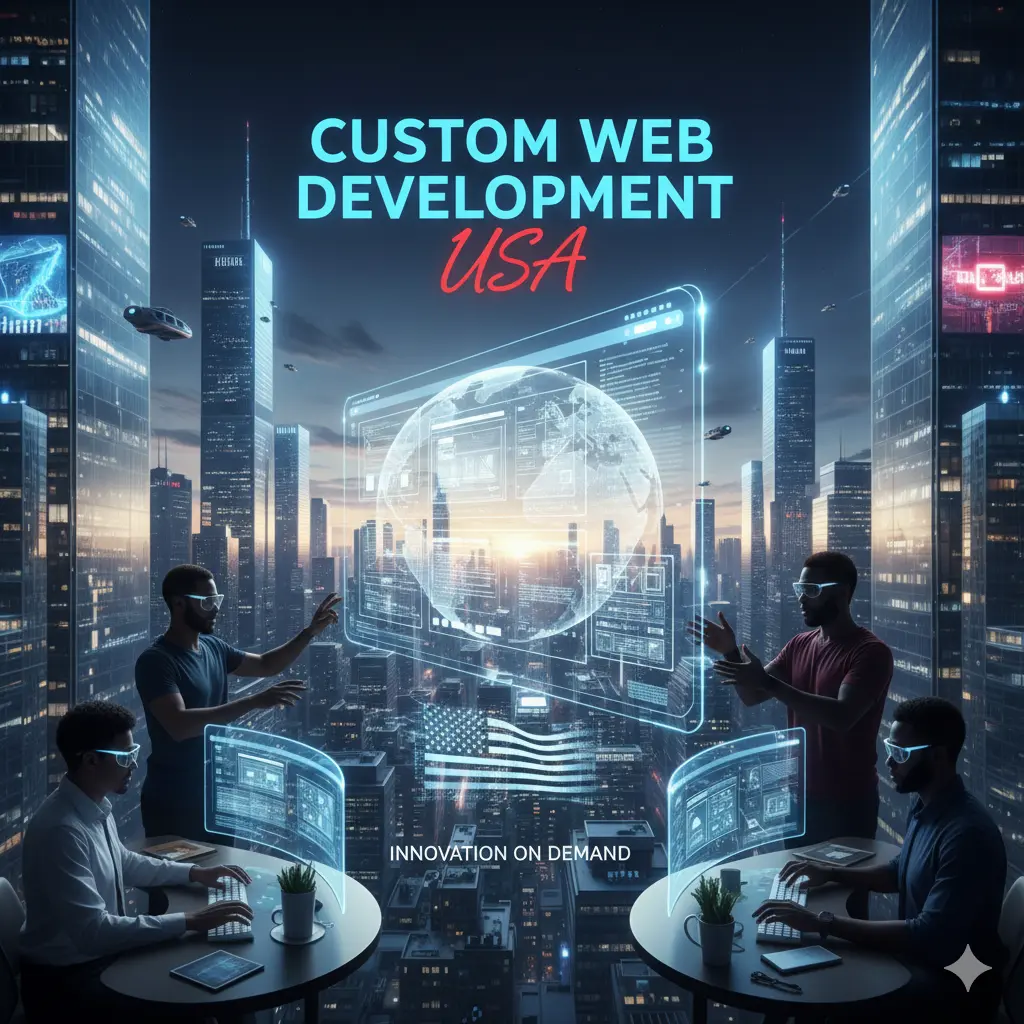Discover everything about custom website development in USA. Learn costs, benefits, process, timelines, and why custom websites outperform templates in 2025.
Custom Website Development in USA: Complete Guide to Tailored Web Solutions
- Homepage
- Insights
- Custom Website Development in USA: Complete Guide to Tailored Web Solutions

The digital landscape in the United States is rapidly evolving, and businesses of all sizes recognize the critical importance of having a strong online presence. However, not all websites are created equal. While template-based solutions offer quick setup and affordability, they often fail to deliver the unique functionality, branding, and performance that modern businesses demand. This is where **custom website development in USA** becomes a game-changer for organizations serious about their digital success.
Custom website development represents a strategic investment in your business’s future. Unlike off-the-shelf solutions, a custom website is built from the ground up, specifically tailored to your business objectives, target audience, and operational requirements. Whether you’re a growing e-commerce business, a professional services firm, a hospitality brand, or an enterprise corporation, custom web development delivers solutions that grow with your business while maintaining superior performance and security.
In this comprehensive guide, we’ll explore everything you need to know about custom website development in the USA—from understanding what it entails to making an informed decision about whether it’s right for your business.
Key Takeaways
- What is Custom Website Development?
- The Custom Website Development Process
- Key Benefits of Custom Website Development
- Custom Website Development vs. Alternative Solutions
- On-Page SEO Specifications for Custom Websites
- Frequently Asked Questions About Custom Website Development in USA
- Conclusion
- 20 FAQS: CUSTOM WEBSITE DEVELOPMENT IN USA
What is Custom Website Development?

Custom website development is the process of building a website from scratch using individual coding and design, rather than relying on pre built templates or drag-and-drop website builders. Each element—from the user interface to the backend infrastructure—is specifically designed and developed to meet your unique business requirements.
Unlike template-based websites that force you into a one-size-fits-all approach, custom websites provide complete freedom to create unique features, integrate specialized tools, and build an online platform that perfectly aligns with your brand identity and business goals.
Custom web development in USA typically involves skilled developers, designers, and project managers working collaboratively throughout several development phases to ensure your website meets all
specifications, performs optimally, and delivers measurable business results.
Key Characteristics of Custom Websites
Custom websites possess several defining characteristics that set them apart from template-based alternatives:
Complete Design Control
– Every pixel, color, font, and interactive element is designed specifically for your brand. There are no pre determined layouts limiting your creativity or brand expression.
Unique Functionality
Build features that are impossible with templates. Custom e-commerce systems, advanced booking platforms, membership portals, and complex integrations become possible with custom development.
Scalability
– Custom websites grow with your business. As your needs evolve, you can add new features, handle increased traffic, and expand functionality without platform constraints.
Performance Optimization
Every line of code is optimized for your specific use case, resulting in faster loading times, better Core Web Vitals scores, and superior user experience.
Security Implementation
Implement security measures tailored to your industry and risk profile, from basic SSL encryption to advanced DDoS protection and compliance frameworks.
SEO Foundation
Built with search engine optimization in mind from day one, custom websites achieve higher rankings through proper architecture, clean code, and optimized performance.
Cost of Custom Website Development in USA
Understanding the financial investment required for custom website development is essential for business planning. Costs vary significantly based on project scope, complexity, and your chosen development partner.
Pricing Breakdown by Website Type
Small Business Websites (8-16 pages)
– Investment Range: $5,000 – $10,000
– Timeline: 4-8 weeks
– Typical Features: Contact forms, basic e-commerce, informational pages, blog integration
– Best For: Local businesses, startups, professional services
Mid-Size Business Websites (12-30 pages)
– Investment Range: $15,000 – $30,000
– Timeline: 8-12 weeks
– Typical Features: Advanced e-commerce, user accounts, content management systems, third-party integrations
– Best For: Growing companies, regional businesses, specialized services
E-Commerce Websites (25-100+ pages)
– Investment Range: $10,000 – $40,000+
– Timeline: 12-16 weeks
– Typical Features: Product catalogs, payment processing, inventory management, customer portals
– Best For: Online retailers, subscription businesses, marketplace platforms
Enterprise Solutions (100+ pages)
– Investment Range: $50,000 – $150,000+
– Timeline: 3-6+ months
– Typical Features: Complex workflows, multi-user systems, advanced analytics, API integrations, white-label options
– Best For: Large corporations, multi-location businesses, complex operations
Additional Cost Considerations
Beyond the primary development budget, consider these supplementary expenses:
Service
Annual Cost
Domain Registration – $10-$15
SSL Certificate – $8-$100+
Web Hosting – $30-$500+
Content Delivery Network (CDN) -$20-$200+
Ongoing Maintenance – $500-$2,500+
Security Monitoring – $50-$500+
The total cost of custom website development reflects the complexity of your requirements, the expertise level of your development team, and the technologies utilized. While initial investment exceeds template-based solutions, the long-term benefits typically justify the expense through superior performance, security, and scalability.
The Custom Website Development Process

Understanding the development process helps set realistic expectations and ensures successful project execution. The typical custom website development follows a structured methodology designed to deliver quality results on time and within budget.
Phase 1: Requirement Gathering and Analysis
The foundation of successful custom website development begins with comprehensive requirement gathering. During this phase, development teams:
– Conduct in-depth interviews with stakeholders to understand business objectives
– Analyze your target audience and user behavior patterns – Research competitive landscape and industry standards – Document specific features and functionality requirements – Identify integration needs with existing business systems – Establish performance benchmarks and success metrics
– Assess security and compliance requirements
This phase typically lasts 1-2 weeks and involves close collaboration between your team and the development agency. The clarity achieved during this stage directly impacts project success and timeline adherence.
Phase 2: Planning and Strategy
With requirements clearly defined, development teams create a comprehensive project strategy:
– Define site architecture and information hierarchy
– Create user journey maps and wireframes
– Select appropriate technology stack (frameworks, databases, languages) – Establish project timeline with milestones
– Allocate resources and assign team members
– Set Core Web Vitals optimization targets
– Plan for mobile-first responsive design implementation – Define accessibility compliance standards (WCAG)
Strategic planning ensures all team members understand project scope, timeline, and deliverables, reducing miscommunication and scope creep.
Phase 3: Design and UX Design
The design phase brings your website to life visually and functionally:
– Develop brand guidelines integration (colors, typography, imagery) – Create wireframes showing page structure and layout
– Design interactive mockups and prototypes
– Implement user experience (UX) best practices
– Create design systems for consistency across pages
– Develop responsive design for all device sizes
– Design user interfaces that enhance engagement
– Get client approval before moving to development
Quality design at this stage prevents costly revisions later and ensures the final website meets user expectations.
Phase 4: Development (Front-End and Back-End)
Development is where the design becomes a functional website:
Front-End Development involves creating the visual interface using: – HTML for structure
– CSS for styling and responsive design
– JavaScript frameworks (React, Vue.js, Angular) for interactivity – Performance optimization techniques
Back-End Development handles server-side operations using: – Server-side languages (Python, PHP, Node.js, Ruby)
– Database design and implementation
– API development for integrations
– Security protocols and encryption
– User authentication and authorization systems
Throughout development, teams follow coding standards, maintain clean code architecture, and implement security best practices.
Phase 5: Quality Assurance and Testing
Comprehensive testing ensures your website functions flawlessly:
– Functional testing of all features and integrations
– Performance testing under various traffic loads
– Security testing for vulnerabilities
– Compatibility testing across browsers and devices
– User acceptance testing (UAT) with stakeholders
– Load testing to ensure scalability
– SEO testing for proper implementation
– Accessibility testing (WCAG compliance)
Thorough testing prevents launch issues and ensures positive user experience.
Phase 6: Deployment and Launch
The deployment phase makes your website live:
– Database migration and setup on production servers
– SSL certificate installation and HTTPS implementation – CDN configuration for optimal content delivery
– DNS configuration and domain setup
– Server security hardening and firewall configuration
– Performance monitoring tools integration
– Backup systems establishment
– Analytics and tracking implementation
Professional deployment ensures smooth transition to production with minimal downtime.
Phase 7: Maintenance and Ongoing Support
After launch, continuous support keeps your website optimal:
– Regular security updates and patch management
– Performance monitoring and optimization
– Content updates and additions
– Feature enhancements based on user feedback
– Technical support for user issues
– Backup and disaster recovery
– Analytics review and optimization recommendations
– Platform upgrades and compatibility maintenance
Key Benefits of Custom Website Development

Investing in custom website development in USA delivers substantial benefits that justify the investment and provide competitive advantages.
Superior SEO Performance
Custom websites are built with search engine optimization as a core principle. You achieve higher rankings through:
– Optimized site architecture and information hierarchy
– Clean, efficient code without bloat
– Fast page loading speeds (Core Web Vitals optimization) – Proper heading hierarchy and semantic HTML
– Mobile-first responsive design
– Customizable metadata and structured data implementation – Built-in SEO best practices and standards compliance
Better SEO rankings directly translate to increased organic traffic, reduced customer acquisition costs, and sustainable business growth.
Enhanced User Experience (UX)
Custom websites prioritize user satisfaction through:
– Intuitive navigation and logical information flow
– Fast, responsive performance across all devices
– Accessibility features for diverse user needs
– Personalized content and recommendations
– Streamlined conversion paths and checkout processes
– Meaningful interactions and microanimations
– Mobile optimization with 70% of traffic coming from mobile
Superior UX leads to increased engagement, longer session durations, and higher conversion rates.
Complete Brand Control
Unlike template websites that limit brand expression, custom websites allow:
– Unique design that reflects your brand identity
– Custom layouts that differentiate you from competitors – Brand-consistent color schemes, typography, and imagery – Proprietary user interface design
– Brand messaging integration throughout the site
– Custom animations and interactive elements
– Professional presentation that builds trust and credibility Strong brand consistency strengthens recognition and customer loyalty.
Scalability and Future-Proofing
Custom websites grow with your business:
– Easily add new features and functionality
– Handle increasing traffic without performance degradation – Integrate new tools and services as needs evolve
– Expand to new markets or product lines
– Accommodate business model changes
– Scale database capacity and server resources
– Maintain performance and security at scale
Scalability ensures your website remains valuable as your business evolves.
Robust Security Implementation
Custom websites implement security measures including:
– SSL/TLS encryption for data protection
– Secure authentication and authorization systems
– DDoS protection and WAF implementation
– Regular security audits and vulnerability testing
– Compliance with industry standards (HIPAA, PCI-DSS, GDPR) – Encrypted data storage and transmission
– Regular backup and disaster recovery systems
Industry-specific security compliance builds customer trust and prevents costly breaches.
Advanced Integration Capabilities
Custom websites seamlessly integrate with:
– Customer Relationship Management (CRM) systems
– Payment gateways and subscription services
– Email marketing platforms
– Analytics and reporting tools
– Accounting software
– Inventory management systems
– Third-party APIs and services
– Custom business applications
Integrated systems streamline operations and reduce manual data entry.
Better Performance and Speed
Custom websites deliver superior performance:
– Optimized code without unnecessary plugins
– Efficient database queries
– Content Delivery Network (CDN) implementation
– Image and asset optimization
– Lazy loading and code splitting
– Caching strategies (browser, server, application)
– Fast Time to First Byte (TTFB)
Faster websites improve user satisfaction and SEO rankings—Google favors fast websites in search results.
Long-Term Cost Efficiency
Though higher initial investment, custom websites provide better ROI:
– No recurring template licensing fees
– Reduced plugin dependency and maintenance
– Scalable without platform replacement
– Better conversion rates and revenue generation
– Lower long-term cost of ownership
– Customizable without third-party limitations
– Competitive advantage justifying premium positioning
Many businesses recover their investment within 12-24 months through improved business results.
Custom Website Development vs. Alternative Solutions

Custom Development vs. WordPress
Factor – Custom Website – WordPress
Development Time – 6-12 weeks -2-4 weeks
Upfront Cost – $5,000-$150,000+ – $500-$5,000
Customization** – Unlimited – Limited by plugins
Performance – Optimized – Requires optimization
Security – Tailored – Depends on plugins
SEO – Built-in – Requires plugins
Scalability- Excellent – Good with optimization Maintenance – Professional support – Community support
Choose Custom Website Development if:
You need complete control, advanced features, superior performance, scalability, or specific integrations beyond WordPress capabilities.
Choose WordPress if:
You need quick setup, lower budget, simple site, and are comfortable with plugin dependencies.
Custom Development vs. Website Builders
Factor – Custom Website – Website Builders
Setup Time – 6-12 weeks – Hours to days
Cost – $5,000+ – $10-$100/month
Design Flexibility
Complete – Template-limited
Features – Custom-built – Pre-built only
Scalability – Unlimited – Platform-limited
SEO – Optimized – Basic
Switching – Full data ownership – Data export issues
Choose Custom Website Development if:
Your business requires unique features, professional branding, scalability, and SEO priority.
Choose Website Builders if:
You want quick launch, minimal technical involvement, and low budget.
Timeline Expectations
Understanding realistic timelines helps with business planning:
Project Duration by Complexity
Small Website (5-10 pages)
– Requirement gathering: 1 week
– Design phase: 2 weeks
– Development: 3-4 weeks
– Testing: 1 week
– Launch: 1 week
– Total: 4-8 weeks
Medium Website (15-25 pages)
– Requirement gathering: 1-2 weeks
– Design phase: 2-3 weeks
– Development: 4-6 weeks
– Testing: 1-2 weeks
– Launch: 1 week
Total: 8-12 weeks
Large/E-Commerce Website (50+ pages)
– Requirement gathering: 2 weeks
– Design phase: 3-4 weeks
– Development: 8-12 weeks
– Testing: 2-3 weeks
– Launch: 1-2 weeks
Total: 12-16+ weeks
Enterprise Solution
– Complete discovery and planning: 4+ weeks
– Comprehensive design: 4-6 weeks
– Full development with complexity: 12-20 weeks
– Extended testing phases: 3-4 weeks
– Launch coordination: 2 weeks
Total: 3-6+ months
Timeline variations occur based on:
– Design approval cycles and revision requests
– Client availability for decisions and feedback
– Integration complexity with existing systems
– Third-party API availability and documentation
– Scope changes or feature additions
– Testing and quality assurance requirements
Emerging Technologies in Custom Web Development (2025)
The custom web development landscape in USA continues to evolve with innovative technologies:
AI-Driven Personalization
Websites now use machine learning to:
– Dynamically adapt content based on user behavior
– Provide personalized product recommendations
– Customize user interfaces per visitor
– Predict user needs and optimize conversion paths
– Generate personalized email and content campaigns
Headless CMS Architecture
Modern custom websites increasingly use:
– Decoupled content and presentation layers
– Flexibility across multiple channels (web, mobile, IoT) – Superior performance compared to traditional CMS
– Simplified development and deployment processes
– Better API-first architecture for integrations
Progressive Web Apps (PWAs)
Custom websites increasingly leverage PWA technology for: – App-like experience without app store distribution
– Offline functionality and reliable performance
– Push notifications and user engagement
– Reduced bandwidth requirements
– Better mobile experience and conversion rates
Advanced Security Frameworks
Enhanced security implementation includes:
– Zero-trust security architecture
– AI-powered threat detection
– Continuous security scanning and monitoring
– Automated vulnerability remediation
– Compliance automation for regulations
Performance Optimization
Modern custom websites implement:
– Core Web Vitals optimization (LCP, FID, CLS)
– Advanced caching strategies
– Image optimization with modern formats (WebP, AVIF)
– Code splitting and lazy loading
– Edge computing and serverless architecture
On-Page SEO Specifications for Custom Websites

Title Tag Optimization
– Length:50-60 characters
– Focus Keyphrase Placement: Beginning of title for maximum impact – Format: Focus keyphrase | Brand name or modifier
– Example: Custom Website Development in USA | Professional Web Solutions
– Yoast Optimization: Title should include focus keyphrase, be compelling, and match search intent
Meta Description Best Practices
– Length: 150-160 characters
– Include: Focus keyphrase, unique value proposition, call-to-action
– Format: Action-oriented, benefit-focused statement
Example: Discover everything about custom website development in USA. Learn costs, benefits, process, timelines, and why custom websites outperform templates in 2025.
Yoast Optimization: Includes keyphrase, matches content, drives clicks from search results
Heading Structure
– H1 Tag: Single unique H1 per page matching page topic (custom website development focus)
– H2 Tags: Primary section headings (3-5 per page)
– H3 Tags:Subsection headings under H2s (supporting structure)
– H6 Tags: Nested hierarchical structure for complex sections
– Yoast Optimization: Proper hierarchy improves readability and SEO signals
Content Optimization
– Word Count: 3,000-5,000+ words for comprehensive topic coverage
– Keyword Density: 1-2% for focus keyphrase (natural inclusion)
– Internal Linking: 3-5 relevant internal links with descriptive anchor text
– External Linking: 3-5 authoritative external links (outbound links build credibility)
– LSI Keywords: Related terms (website development services, custom web design, responsive websites)
– Readability: Clear sentences, short paragraphs, bullet points for scanability
Image Optimization
– File Names: Descriptive, include focus keywords where relevant
– Alt Text: Unique descriptions including keywords, 8-15 words
– Image Size: Optimized for web (under 100KB for web images)
– Format: Use modern formats (WebP) with fallbacks
– Compression: Maintain quality while reducing file size URL/Slug Optimization
– Format: Lowercase, hyphenated words
– Length: Short, descriptive (3-5 words)
– Focus Keyphrase: Include primary keyword when natural
– Slug: custom-website-development-in-usa
– Yoast Optimization: Clean, descriptive URLs improve crawlability and user experience
Schema Markup Implementation
Implement structured data for enhanced search results:
– Article Schema: Author, publication date, content type
– Organization Schema: Business name, address, contact information
– LocalBusiness Schema: For location-specific services
– Product/Service Schema:** For offerings and pricing
– FAQ Schema: For frequently asked questions
Page Speed and Technical SEO
– Page Load Time: Under 3 seconds (target 1-2 seconds)
-Mobile Responsiveness: 100% responsive across all devices – Core Web Vitals:
– LCP (Largest Contentful Paint): Under 2.5 seconds
– FID (First Input Delay): Under 100 milliseconds
– CLS (Cumulative Layout Shift): Under 0.1
– SSL Certificate: HTTPS implementation mandatory
– XML Sitemap: Includes all important pages
– Robots.txt: Properly configured for crawler guidance
Internal Linking Strategy
– Anchor Text: Descriptive, includes keywords naturally
– Link Placement: 3-5 relevant internal links per 1000 words
– Context: Links placed in relevant content sections
– Target Pages: Link to important pages and category pages
– Depth: Links help establish information hierarchy
Frequently Asked Questions About Custom Website Development in USA

What exactly is custom website development?
Custom website development is the process of building a website from scratch, tailored specifically to your business needs. Unlike template based solutions, custom websites are coded individually to create unique features, designs, and functionalities that align perfectly with your brand identity and business objectives.
How much does custom website development cost in the USA?
Custom website development costs typically range from $5,000 to $150,000+, depending on complexity. Small business websites cost $5,000- $10,000, mid-range websites $15,000-$30,000, and enterprise-level websites $50,000-$150,000 or more. Costs vary based on features, integrations, and development time required.
How long does custom website development take?
Most custom websites take 6-12 weeks from start to launch. Simple websites may take 4-8 weeks, while complex projects with advanced features, integrations, or e-commerce functionality can take 3-6 months or longer depending on scope and revisions.
What are the main steps in custom website development?
The typical custom website development process includes: (1) Requirement gathering and analysis, (2) Planning and strategy, (3) Design and UX design, (4) Development (front-end and back-end), (5) Quality assurance and testing, (6) Deployment and launch, and (7) Maintenance and updates.
Is custom website development better than WordPress?
Both have advantages. Custom websites offer complete control, better SEO optimization, scalability, and unique features but cost more and take longer. WordPress is faster to set up, more affordable, and easier to manage but has limitations in customization and may require multiple plugins for complex functionality.
What are the key benefits of custom website development?
Key benefits include: unique brand identity, complete design control, superior SEO optimization, enhanced user experience, scalability for business growth, robust security features, faster loading times, third party integrations, and long-term ROI through tailored solutions.
Can custom websites handle high traffic?
Yes, custom websites are designed with scalability in mind. They use autoscaling infrastructure, load balancing, caching strategies, and optimized databases to handle peak traffic efficiently. This makes them ideal for businesses expecting growth or experiencing seasonal traffic spikes.
What makes a custom website mobile-friendly?
Custom websites implement mobile-first design principles, responsive layouts using CSS media queries, flexible grid systems, optimized images,
and fast loading times. Over 70% of web traffic comes from mobile devices, making mobile optimization essential for success.
How does custom website development improve SEO?
Custom websites are built with SEO in mind from the ground up. They offer better page speed, proper HTML structure, mobile optimization, customizable metadata, improved site architecture, clean code, and the ability to implement advanced SEO strategies—all crucial for ranking higher in search results.
What security features should a custom website have?
Essential security features include SSL/TLS encryption, secure authentication protocols, DDoS protection, firewalls, regular security updates, OWASP compliance, data encryption, secure hosting infrastructure, and regular security audits. Custom websites allow implementation of industry-specific security standards.
Can I integrate third-party tools with a custom website?
Absolutely. Custom websites excel at third-party integrations. You can seamlessly connect CRM systems, payment gateways, email marketing platforms, analytics tools, chatbots, accounting software, and other business applications to streamline operations and enhance functionality.
What is the difference between front-end and back-end development?
Front-end development focuses on the user-facing interface using HTML, CSS, and JavaScript—what visitors see and interact with. Back-end development handles server-side operations, databases, and logic using languages like Python, PHP, or Node.js—powering the website’s functionality behind the scenes.
Is custom website development scalable?
Yes, custom websites are highly scalable. As your business grows, you can add new features, expand functionality, handle increased traffic, and integrate additional services without the limitations often found in template-based platforms. This ensures your website grows with your business.
What technologies are best for custom website development?
Popular technologies include React and Vue.js for front-end, Node.js, Python, or PHP for back-end, databases like PostgreSQL or MongoDB, and frameworks like Django or Laravel. The choice depends on your specific requirements, scalability needs, and development team expertise.
How do I choose the right custom website development company?
Look for companies with proven portfolio experience in your industry, technical expertise in required technologies, clear communication, transparent pricing, post-launch support, positive client reviews, and understanding of your business goals. Check their certifications and past project timelines.
What ongoing maintenance does a custom website need?
Custom websites require regular updates for security patches, performance optimization, content updates, backup maintenance, monitoring for downtime, bug fixes, and feature enhancements. Most businesses allocate ongoing maintenance budgets to ensure their website remains secure, fast, and functional.
Can e-commerce stores be custom developed?
Yes, custom e-commerce development offers superior capabilities over platforms like Shopify. You get complete control over payment gateways, inventory management, customer experience, and advanced features like personalized recommendations, multi-vendor systems, and custom checkout processes.
What is the ROI of custom website development?
While initial costs are higher than templates, custom websites deliver superior long-term ROI through better conversions, improved SEO rankings, reduced bounce rates, and scalability. Many businesses see return on investment within 12-24 months through increased sales and reduced operational costs.
Are custom websites faster than template-based websites?
Custom websites typically load faster because they’re optimized specifically for your needs without bloated code or unnecessary plugins. Optimized code, efficient databases, proper caching, and CDN implementation result in significantly faster page speeds—crucial for SEO and user experience.
Can I update and manage a custom website myself?
It depends on the architecture. Some custom websites use CMSs like WordPress for easy content management, while others require developer assistance for updates. Modern custom websites often include user friendly admin panels allowing non-technical users to manage content, images, and basic settings independently.
Conclusion

Custom website development in USA represents a strategic investment in your business’s digital future. While the initial cost and timeline exceed template-based alternatives, the benefits—superior performance, complete brand control, scalability, security, and SEO optimization justify the investment for serious businesses.
The choice between custom development and alternative solutions depends on your specific needs, budget, timeline, and growth projections. For businesses requiring unique features, advanced functionality, professional branding, and long-term scalability, custom website development delivers unmatched value and competitive advantage in an increasingly digital marketplace.
By understanding the development process, realistic costs, timeline expectations, and strategic benefits of custom web development, you’re equipped to make an informed decision that aligns with your business objectives and positions your company for sustainable growth and digital success.
20 FAQS: CUSTOM WEBSITE DEVELOPMENT IN USA
Custom website development is the process of building a website from scratch, tailored specifically to your business needs. Unlike template-based solutions, custom websites are coded individually to create unique features, designs, and functionalities that align perfectly with your brand identity and business objectives.
Custom website development costs in the USA typically range from $5,000 to $150,000+, depending on complexity. Small business websites cost $5,000-$10,000, mid-range websites $15,000-$30,000, and enterprise-level websites $50,000-$150,000 or more. Costs vary based on features, integrations, and development time required.
Most custom websites take 6-12 weeks from start to launch. Simple websites may take 4-8 weeks, while complex projects with advanced features, integrations, or e-commerce functionality can take 3-6 months or longer depending on scope and revisions.
The typical custom website development process includes: (1) Requirement gathering and analysis, (2) Planning and strategy, (3) Design and UX design, (4) Development (front-end and back-end), (5) Quality assurance and testing, (6) Deployment and launch, and (7) Maintenance and updates.
Both have advantages. Custom websites offer complete control, better SEO optimization, scalability, and unique features but cost more and take longer. WordPress is faster to set up, more affordable, and easier to manage but has limitations in customization and may require multiple plugins for complex functionality.
Key benefits include: unique brand identity, complete design control, superior SEO optimization, enhanced user experience, scalability for business growth, robust security features, faster loading times, third-party integrations, and long-term ROI through tailored solutions.
Yes, custom websites are designed with scalability in mind. They use autoscaling infrastructure, load balancing, caching strategies, and optimized databases to handle peak traffic efficiently. This makes them ideal for businesses expecting growth or experiencing seasonal traffic spikes.
Custom websites implement mobile-first design principles, responsive layouts using CSS media queries, flexible grid systems, optimized images, and fast loading times. Over 70% of web traffic comes from mobile devices, making mobile optimization essential for success.
Custom websites are built with SEO in mind from the ground up. They offer better page speed, proper HTML structure, mobile optimization, customizable metadata, improved site architecture, clean code, and the ability to implement advanced SEO strategies—all crucial for ranking higher in search results.
Essential security features include SSL/TLS encryption, secure authentication protocols, DDoS protection, firewalls, regular security updates, OWASP compliance, data encryption, secure hosting infrastructure, and regular security audits. Custom websites allow implementation of industry-specific security standards.
Absolutely. Custom websites excel at third-party integrations. You can seamlessly connect CRM systems, payment gateways, email marketing platforms, analytics tools, chatbots, accounting software, and other business applications to streamline operations and enhance functionality.
Front-end development focuses on the user-facing interface using HTML, CSS, and JavaScript—what visitors see and interact with. Back-end development handles server-side operations, databases, and logic using languages like Python, PHP, or Node.js—powering the website's functionality behind the scenes.
Yes, custom websites are highly scalable. As your business grows, you can add new features, expand functionality, handle increased traffic, and integrate additional services without the limitations often found in template-based platforms. This ensures your website grows with your business.
Popular technologies include React and Vue.js for front-end, Node.js, Python, or PHP for back-end, databases like PostgreSQL or MongoDB, and frameworks like Django or Laravel. The choice depends on your specific requirements, scalability needs, and development team expertise.
Look for companies with proven portfolio experience in your industry, technical expertise in required technologies, clear communication, transparent pricing, post-launch support, positive client reviews, and understanding of your business goals. Check their certifications and past project timelines.
Custom websites require regular updates for security patches, performance optimization, content updates, backup maintenance, monitoring for downtime, bug fixes, and feature enhancements. Most businesses allocate ongoing maintenance budgets to ensure their website remains secure, fast, and functional.
Yes, custom e-commerce development offers superior capabilities over platforms like Shopify. You get complete control over payment gateways, inventory management, customer experience, and advanced features like personalized recommendations, multi-vendor systems, and custom checkout processes.
While initial costs are higher than templates, custom websites deliver superior long-term ROI through better conversions, improved SEO rankings, reduced bounce rates, and scalability. Many businesses see return on investment within 12-24 months through increased sales and reduced operational costs.
Custom websites typically load faster because they're optimized specifically for your needs without bloated code or unnecessary plugins. Optimized code, efficient databases, proper caching, and CDN implementation result in significantly faster page speeds—crucial for SEO and user experience.
It depends on the architecture. Some custom websites use CMSs like WordPress for easy content management, while others require developer assistance for updates. Modern custom websites often include user-friendly admin panels allowing non-technical users to manage content, images, and basic settings independently.
Share this post :
Newsletter
Add Your Heading Text Here
Lorem ipsum dolor sit amet, consectetur adipiscing elit. Ut elit tellus, luctus nec ullamcorper mattis, pulvinar dapibus leo.


































